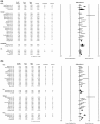The Acute Neuromuscular Responses to Cluster Set Resistance Training: A Systematic Review and Meta-Analysis
- PMID: 31506904
- PMCID: PMC6851217
- DOI: 10.1007/s40279-019-01172-z
The Acute Neuromuscular Responses to Cluster Set Resistance Training: A Systematic Review and Meta-Analysis
Abstract
Background: Cluster sets (CSs) are a popular resistance training (RT) strategy categorised by short rest periods implemented between single or groups of repetitions. However, evidence supporting the effectiveness of CSs on acute intra-session neuromuscular performance is still equivocal.
Objective: The objective of this investigation was to determine the efficacy of a single session of CSs to attenuate losses in force, velocity and power compared to traditional set (TS) training.
Methods: Screening consisted of a systematic search of EMBASE, Google Scholar, PubMed, Scopus and SPORTDiscus. Inclusion criteria were (1) measured one or more of mean/peak force, velocity or power; (2) implemented CSs in comparison to TSs; (3) an acute design, or part thereof; and (4) published in an English-language, peer-reviewed journal. Raw data (mean ± standard deviation) were extracted from included studies and converted into standardised mean differences (SMDs) and ± 95% confidence intervals (CIs).
Results: Twenty-five studies were used to calculate SMD ± 95% CI. Peak (SMD = 0.815, 95% CI 0.105-1.524, p = 0.024) and mean (SMD = 0.863, 95% CI 0.319-1.406, p = 0.002) velocity, peak (SMD = 0.356, 95% CI 0.057-0.655, p = 0.019) and mean (SMD = 0.692, 95% CI 0.395-0.990, p < 0.001) power, and peak force (SMD = 0.306, 95% CI - 0.028 to 0.584, p = 0.031) favoured CS. Subgroup analyses demonstrated an overall effect for CS across loads (SMD = 0.702, 95% CI 0.548-0.856, p < 0.001), included exercises (SMD = 0.664, 95% CI 0.413-0.916, p < 0.001), experience levels (SMD = 0.790, 95% CI 0.500-1.080, p < 0.001) and CS structures (SMD = 0.731, 95% CI 0.567-0.894, p < 0.001) with no difference within subgroups.
Conclusion: CSs are a useful strategy to attenuate the loss in velocity, power and peak force during RT and should be used to maintain neuromuscular performance, especially when kinetic outcomes are emphasised. However, it remains unclear if the benefits translate to improved performance across all RT exercises, between sexes and across the lifespan.
Conflict of interest statement
Christopher Latella, Wei-Peng Teo, Eric J. Drinkwater, Kristina Kendall and G. Gregory Haff declare that they have no conflict of interest.
Figures





References
-
- Cronin J, Sleivert G. Challenges in understanding the influence of maximal power training on improving athletic performance. Sports Med. 2005;35(3):213–234. - PubMed
-
- Suchomel TJ, Nimphius S, Stone MH. The importance of muscular strength in athletic performance. Sports Med. 2016;46:1419–1449. - PubMed
-
- Suchomel TJ, Mimphius S, Bellon CR, Stone MH. The importance of muscular strength: training considerations. Sports Med. 2018;48(4):765–785. - PubMed
-
- Morrissey MC, Harman EA, Johnson MJ. Resistance training modes: specificity and effectiveness. Med Sci Sports Exerc. 1995;27(5):648–660. - PubMed
Publication types
MeSH terms
LinkOut - more resources
Full Text Sources
Medical

